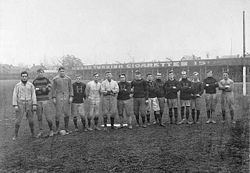As was the case in Britain, by the early 19th century, North American schools and universities played their own local games, between sides made up of students. Students at Dartmouth College in New Hampshire played a game called Old division football, a variant of the association football codes, as early as the 1820s.
The first game of rugby in Canada is generally said to have taken place in Montreal, in 1865, when British Army officers played local civilians. The game gradually gained a following, and the Montreal Football Club was formed in 1868, the first recorded football club in Canada.
In 1869, the first game played in the United States under rules based on the English FA (soccer) code occurred, between Princeton and Rutgers. This is also often considered to be the first US game of college football, in the sense of a game between colleges (although the eventual form of American football would come from rugby, not soccer).
Modern American football grew out of a match between McGill University of Montreal, and Harvard University in 1874. At the time, Harvard students are reported to have played the Boston Game — a running code — rather than the FA-based kicking games favored by US universities. This made it easy for Harvard to adapt to the rugby-based game played by McGill and the two teams alternated between their respective sets of rules. Within a few years, however, Harvard had both adopted McGill's rugby rules and had persuaded other US university teams to do the same. In 1876, at the Massasoit Convention, it was agreed by these universities to adopt most of the Rugby Football Union rules. However, a touch-down only counted toward the score if neither side kicked a field goal. The convention decided that, in the US game, four touchdowns would be worth one goal; in the event of a tied score, a goal converted from a touchdown would take precedence over four touch-downs.
Princeton, Rutgers and others continued to compete using soccer-based rules for a few years before switching to the rugby-based rules of Harvard and its competitors. US colleges did not generally return to soccer until the early twentieth century.
In 1880, Yale coach Walter Camp, devised a number of major changes to the American game, beginning with the reduction of teams from 15 to 11 players, followed by reduction of the field area by almost half, and; the introduction of the scrimmage, in which a player heeled the ball backwards, to begin a game. These were complemented in 1882 by another of Camp's innovations: a team had to surrender possession if they did not gain five yards after three downs (i.e. successful tackles).
Over the years Canadian football absorbed some developments in American football, but also retained many unique characteristics. One of these was that Canadian football, for many years, did not officially distinguish itself from rugby. For example, the Canadian Rugby Football Union, founded in 1884 was the forerunner of the Canadian Football League, rather than a rugby union body. (The Canadian Rugby Union was not formed until 1965.) American football was also frequently described as "rugby" in the 1880s.


No comments:
Post a Comment